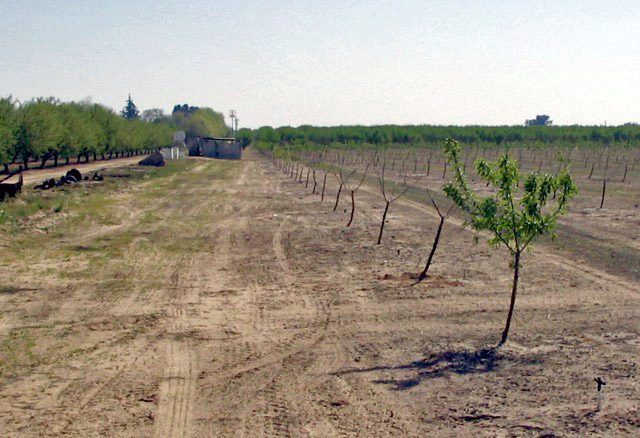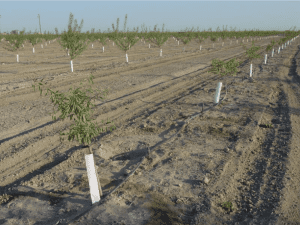
Alternative rootstocks may be a tool to keep in your back pocket if or when fumigation of a second-generation orchard site becomes a regulatory or costly headache.
UCCE Pomology Advisor Roger Duncan said a trial he started in 2014 showed almond rootstock choices can make a much larger impact on tree performance and profitability than even fumigation with Telone C35 in replant situations.
“Fumigation of second- or third-generation almond orchard sites may not be feasible in the future,” Duncan said. “Our recommendation to growers has always been to fumigate second-generation almond orchard sites prior to replanting.”
Soil sampling will show parasitic nematode levels at the site, but Duncan said there is not a soil test to show if replant disease is present in the soil. “There is no test to predict if the orchard site has this disease complex called replant disease, or Prunus Replant Disease (PRD),” Duncan said. “It is difficult to know if it will be a problem. It is always best to assume it will be a problem.
“Replant disease is really not well defined yet. It is a disease complex; not just one thing causes the disease,” Duncan said. Replant disease is associated with several species of plant-parasitic fungi and Pythium and Phytophthora oomycetes. It is more common on loam, sandy loam and sandy soil textures in California.
Implications of Replant Disease
The disease causes slight to severe growth suppression in almond and stone fruit orchards planted after an existing almond or stone fruit orchard is removed. Trees affected by this disease, particularly during the first year after planting, may never reach the same growth and productivity of unaffected trees. This affects uniformity of an orchard and, in addition to loss of potential yield from affected trees, makes management challenging.
The common sequence of events in an orchard replant begins with tree removal. After soil sampling to determine nematode levels at the site, fumigation with Telone, chloropicrin or a combination of both is performed (Duncan recommends soil sampling before the old orchard is removed for better results and so new trees can be ordered with the best rootstock.) Several months later, after fumigation chemicals have dissipated, the new orchard is planted.
Replant disease can occur with or without significant populations of phytopathogenic nematodes, Duncan said. Root damage from nematode feeding can persist over the economic life of orchards.
Duncan firmly advises that replanting an almond orchard without fumigation is risky. Most growers do fumigate orchard sites prior to replanting, he said, but a few do not. Until there is a reliable test to determine if replant disease will have a serious impact on a new orchard, he recommends fumigation. A few growers have tried cutting costs by substituting fumigation with post-plant nematicides and even soil-applied fungicides, but Duncan thinks that is risky and may end up costing more in lost production in the long run. Even with the high cost of fumigation, it has almost always paid for itself with more uniform, productive orchards within a short time.
Duncan said there is no second chance after a decision has been made to not fumigate.
Cost May Impact Fumigant Use
The recommendation to fumigate is based on results of many UC field trials comparing fumigated and unfumigated soils of numerous types.
Looking down the road, Duncan said increased regulation and higher fumigant costs may impact its use. There are increasingly situations where fumigant restrictions will not allow use, including orchard sites near homes or schools. Township caps on use of Telone II can also impact availability to apply in replant situations.
In Duncan’s post on the UCCE publication San Joaquin Valley Trees and Vines, he notes that chloropicrin with or without Telone II has been shown to elicit better growth responses in replanted orchards than Telone alone. Chloropicrin is more effective against fungal or bacterial pathogens, while Telone is used for nematode control. Telone C35 is a mixture of the two that is widely used in replant situations.
The 2014, trials began after a peach orchard on Nemaguard rootstock was removed in the fall. The plans were to plant almonds at the site. Duncan reported that parts of the future tree rows were strip fumigated with C35 at a rate of 46.5 gallons per acre. The remainder of the rows were not fumigated.

Rootstock Trials
The almond orchard was planted in 2015 to Nonpareil on five different rootstocks: Viking, Hansen 536, Empyrean 1, Rootpac R and Nemaguard in both the fumigated and unfumigated rows.
Duncan reported that through the sixth leaf, yields were improved in trees on fumigated soils with Nemaguard, Viking and Rootpac R by a few hundred pounds per acre. Yield differences, he noted were smaller than expected at the site, but sufficient to cover fumigation cost. Similar performance in unfumigated and fumigated soils were found with trees on Hansen and Empyrean 1 rootstocks. The superior performance of Hansen and Empyrean in unfumigated soils concurs with earlier trials by Dr. Greg Browne.
The larger impact of rootstock was noted with Empyrean 1 on unfumigated soil. Those unfumigated trees outyielded trees on Nemaguard that were growing in fumigated soil by 2,084 pounds per acre through the sixth leaf. Hansen rootstock trees in unfumigated soil also out-yielded Nemaguard trees on fumigated soil by 1,733 pounds per acre. Duncan noted that the 2019 yield was impacted by bacterial blast on all rootstocks.
“This was one of many rootstock trials that have been done by the University of California. ” Duncan said. Rootstocks can make a difference in any soil, but they are especially important in soils with particular challenges like diseases or soil chemistry problems.
The trial also showed trees on Rootpac R are substantially smaller than trees on Nemaguard, whether fumigated or not, and have yielded roughly half compared to those on Nemaguard. Rootpac R is probably not best suited for sandy or sandy loam soils.
Duncan noted that although trees on Hansen have performed well in the trial, in unfumigated soils supporting large numbers of ring nematodes, peach/almond hybrid rootstocks may be more susceptible to bacterial canker.
It is risky, he said, to plant a peach/almond hybrid rootstock like Hansen in soil that will support ring nematodes without preplant fumigation.

Cecilia Parsons | Associate Editor
Cecilia Parsons has lived in the Central Valley community of Ducor since 1976, covering agriculture for numerous agricultural publications over the years. She has found and nurtured many wonderful and helpful contacts in the ag community, including the UCCE advisors, allowing for news coverage that focuses on the basics of food production.
She is always on the search for new ag topics that can help growers and processors in the San Joaquin Valley improve their bottom line.
In her free time, Cecilia rides her horse, Holly in ranch versatility shows and raises registered Shetland sheep which she exhibits at county and state fairs during the summer.















